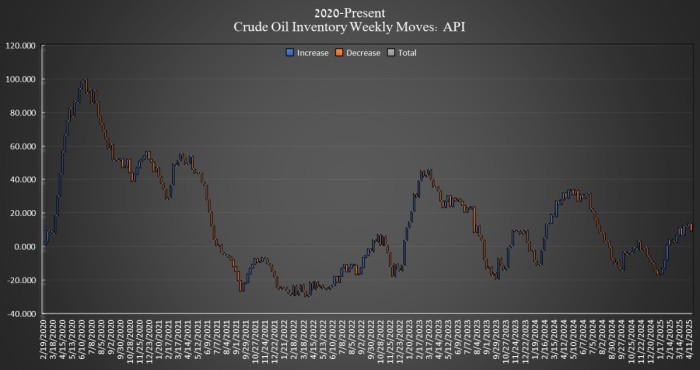Oil Prices Rebound As Inventory Slips

The American Petroleum Institute (API) estimated that crude oil inventories in the United States fell 4.565 million barrels in the week ending April 18. The API estimated a 2.4 million barrel build in the prior week.
So far this year, crude oil inventories are still up more than 19 million barrels, according to Oilprice calculations of API data.
Earlier this week, the Department of Energy (DoE) reported that crude oil inventories in the Strategic Petroleum Reserve (SPR) climbed 500,000 barrels to 397.5 million barrels in the week ending April 18. Inventory levels in the SPR are hundreds of millions shy of the levels in inventory prior to the SPR withdrawal that took place under the Biden Administration.
At 3:07 pm ET, Brent crude was trading up $1.00 (+1.51%) on the day, leaving the international benchmark at $67.26. While down on the day, it is a $3 rebound from this time last week, and an almost $6 rebound from the lows following the announcement of the Liberation Day tariffs.
WTI was also trading up on the day, by $1.12 (+1.48%) at $64.20—also a $3 per barrel increase over last week’s level.
Gasoline inventories also fell in the week ending April 18, by 2.180 million barrels, after falling by 3 million barrels in the week prior. As of last week, gasoline inventories are now 1% below the five-year average for this time of year, according to the latest EIA data.
Distillate inventories were also down this week, by 1.640 million barrels in the latest week. In the week prior, distillate inventories fell by 3.2 million barrels. Distillate inventories were already about 11% below the five-year average as of the week ending April 11, the latest EIA data shows.
Cushing inventories—the benchmark crude stored and traded at the key delivery point for U.S. futures contracts in Cushing, Oklahoma—fell by 354,000 barrels, the API data showed, more than offsetting last week’s 349,000 barrel hike.




